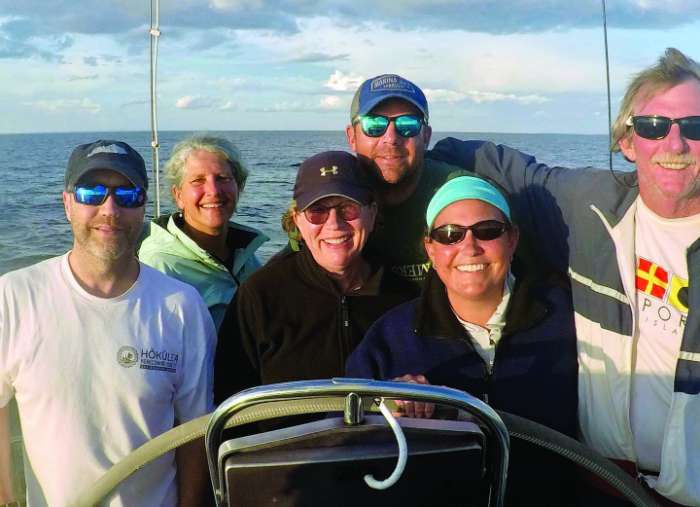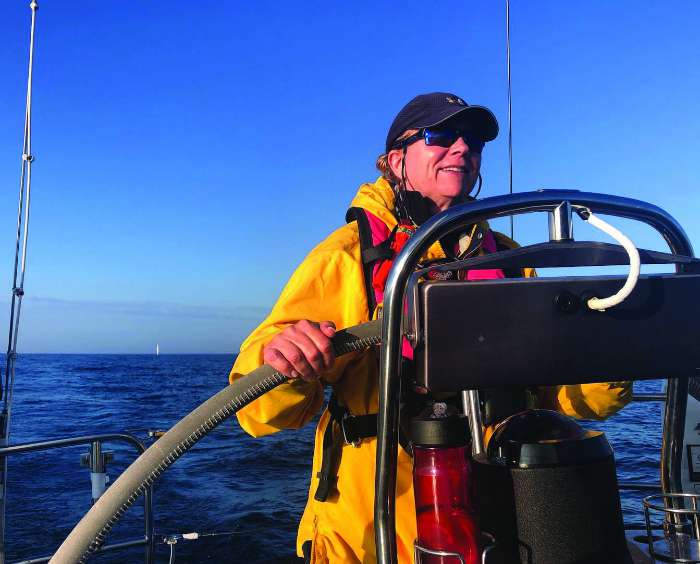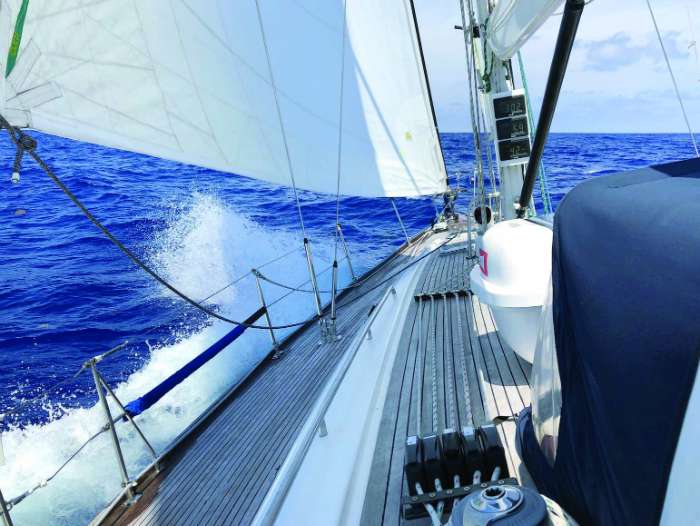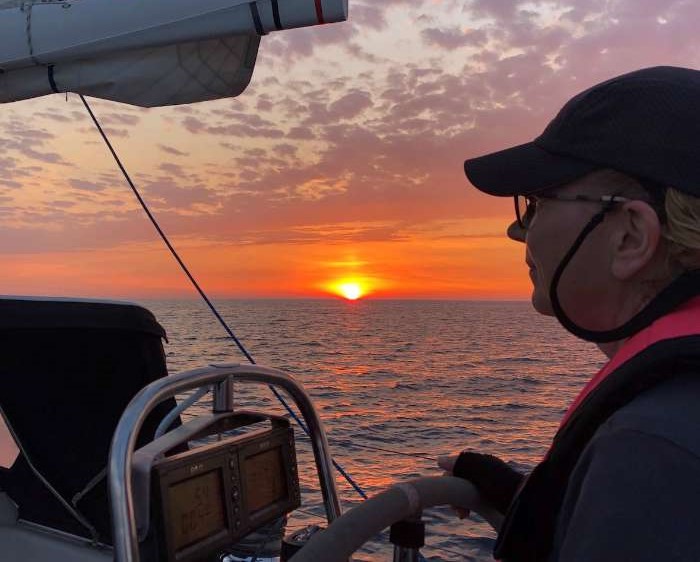Hands-On Offshore Sailing Experience (With a Famous Captain)
When I started cruising 15 years ago, I read countless books about offshore sailing. I stumbled upon “Maiden Voyage” by Tania Aebi, and her story captivated me. At 18, Tania left New York to solo-circumnavigate the world on a 26-foot sailboat. That was in May 1985, before GPS, electronic charts, and affordable communications. With no one else onboard for companionship or assistance, Tania successfully returned two and a half years later and wrote her best-selling book.
While I never set ocean-crossing goals for myself, I did dream of sailing to the Caribbean and the Bahamas. So, I joined Offshore Passagemaking Opportunities (OPO) with the hopes of crewing in exchange for valuable experience.

Offshore crew opportunities
In addition to crew prospects, I learned about OPO’s Swan program, which provides “hands-on offshore crew experience under the watchful eye of a professional skipper on a proven boat.” Captain Aebi was often the skipper. This sounded like offshore learning I could get excited about! I certainly knew the captain was qualified. The reasonably priced program would offer opportunities to navigate, keep watch, prepare meals underway, and push me beyond my comfort zone.
When OPO announced that Captain Aebi would deliver a Swan 48 from Bermuda to Huntington, NY, I eagerly submitted my sailing resume, mentioning my 50-ton captain’s license in addition to other coursework. I was accepted!
Preparing to go offshore
Then, it got real. OPO sent me a 20-page guide that described safety equipment, what to pack, and life onboard. I still had questions concerning berth assignments, number of heads, charging capabilities, and if the boat had AIS. I rented a personal locator beacon to attach to my inflatable PFD. I purchased a 60L Patagonia duffle, perfectly sized even with foul weather gear, and carried a daypack for sundries. To facilitate living out of a duffle, I bought organizing cubes for clothing. I opted to wear my Timex digital watch rather than a watch that needed charging.
Before I knew it, I was landing in Bermuda and taking a cab to our boat, Avocation’s, dock. There I met the captain and four other crew and received a firehose of information about boat systems, safety, and passagemaking. However, I was disheartened to learn that we only had one working head for six people and that the AIS wasn’t working. After selecting our berths, we walked to St. George’s and bonded over dinner.

We’re off!
The next morning, we returned to town to provision, thankful that the market delivered. Tania received updated weather reports and chose our route based on Gulf Stream eddies and wind forecasts. I helped her plot the course on paper charts. In the hour before departing, we topped off water tanks, showered, and notified customs we were leaving. The watch schedule began at 6 p.m. Each person was assigned three-hour shifts in the cockpit: half at the helm, and the remainder seated nearby to assist if needed.
My first watch began at 1:30 a.m. I was seasick. I’d never gotten seasick. Never! Perhaps it was anxiety or being below in pitching seas. Initially, I refused to take medication due to side effect concerns. I never missed a watch, but when returning below, I had to get horizontal immediately. Using the head was especially challenging. After 24 hours of malaise, I took a Dramamine and within hours I was better.
Settling in
By the second full day at sea, I was back to normal. I could write in my journal, read books, cook on the gimbaled stove, and even eat meals! I got to know the other five boat mates and found them warm and engaging. Each evening, we gathered to watch sunsets together, though we never saw the green flash.
As days progressed, sleeping with a lee cloth while heeling became easier. I also learned to sleep when off watch so that I would be alert when on watch. I woke 30 minutes before my watches to allow time to dress in layers, use the head, refill my water bottle, grab food, and don my PFD.
At the helm, autopilot was not allowed due to battery drain and encouragement to learn how to helm in ocean waves. Depending on wind angle and speed, I sometimes found it challenging to keep on course without being able to aim at something as I did on the Chesapeake. Despite utter darkness, I looked forward to helming at night, enjoying the peaceful phosphorescence in our wake as it blended into the starry night.

The Gulf Stream
On our fifth day at sea, we entered the Gulf Stream at 5:30 p.m. and exited four and a half hours later. The water was mesmerizingly blue. Dolphins played at our bow, and we saw three whales spouting in the distance. I pinched myself.
But the Gulf Stream was surprisingly tranquil, and we were motoring more than anticipated. We had just emptied the last jerry cans of fuel yet were still two days from Newport. We were also low on potable water.
After the Gulf Stream, we encountered cooler air, bigger seas, and stronger winds. We were glad we had practiced reefing sails during calm spells so we would be prepared to reef in the dark and in rougher seas.
A close encounter
At 10:30 at night the next day, as I arrived for my watch, I saw a ship on the nav station’s radar about nine nautical miles out “at three o’clock” on our beam. It was only a faint glow on the horizon. Twenty minutes later it was six nautical miles out, visible through binoculars, and seemed to be paralleling our course.
I saw red and green lights, far apart, heading straight for us! Our tricolor was on, but we added running lights, illuminated our sails with spreader lights, and turned on the engine to propel us rapidly forward. Tania called on the radio. Eventually the ship responded, stating that they saw us and would pass behind. Gripping the helm, my eyes were trained ahead as Tania and crew attempted to increase speed. We felt their wake! Tania estimated the ship passed our stern by 100 yards in the middle of the vast ocean. Way too close for comfort!

Spirited sail finale
Through the dawn mist on our seventh day, we saw Block Island’s wind farm and shouted “land-ho.” After refueling in Newport and digitally checking into customs, we had a spirited sail down Long Island Sound. We topped nine knots of speed at one point while dodging numerous storms. We had been seven days in the ocean, and the worst weather of the voyage was in Long Island Sound!
Finally, we docked at 3:20 a.m. at Huntington Yacht Club. We slept for a few hours and walked into town for a celebratory breakfast. Before catching my train home, I asked Tania to sign two of her books (one for a friend) and Form 719-S to document my sea time. She smiled and said, “Of course.” I treasure both autographs.
Sailing with Captain Tania Aebi remains one of the highlights of my life. The lessons I learned during that week of offshore sailing prepared me well for subsequent journeys on my boat and others.
About the author: Captain Cheryl Duvall is a USCG Licensed Master, Inland 100 GRT, and is program director for the Chesapeake Area Professional Captains Association (CAPCA). She recently joined Watermark and enjoys being at the helm of the Miss Anne in Annapolis. She can be reached at [email protected].




